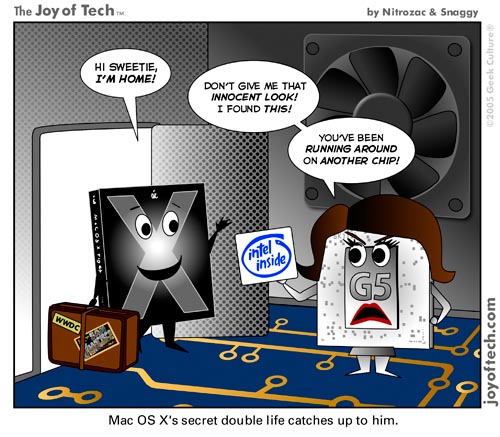BitDepth 478 - June 21
11/01/09 17:43 Filed in: BitDepth - June 2005
In Hell, a cool wind is blowing as Macs switch processors to Intel chips.
Macs with Intel inside

The Mac operating system's cheating ways revealed. Cartoon courtesy Nitrozac and Snaggy of The Joy of Tech. See more strips at www.joyoftech.com.
Once Steve Jobs announced earlier this month that the Macintosh line of computers from the Power PC chips made by IBM and Motorola would move to Intel, speculation has been the order of the day in computing circles.
The most intriguing political speculation suggests an Intel-Mac liaison designed to mount an assault on the Microsoft juggernaut now that Microsoft has dropped Intel's chips in its next generation Xbox. But even the wildest speculation isn't as important to Mac users as the stagnant state of Power PC development in recent years.
The Power PC chip, co-developed by Apple, IBM and Motorola at the start of the nineties and now in its fifth generation has had only fitful progress as an engine for desktop and server computers. Both Motorola and IBM have shifted focus to less demanding embedded systems in appliances and automobiles.
I've watched processors for my chosen computer, the Macintosh PowerBook, crawl from 1GHZ to 1.67GHZ over three years. Meanwhile, equivalent chips from Intel have introduced revolutionary power saving features that extend battery life by hours.
Nothing's drastically wrong with the Power PC right now, but clearly development is way behind projections, and the roadmap that Apple was depending on to maintain parity with its Windows based competition is now showing wrong turns.
With Intel processors for laptops running at 2.6 GHZ and above right now, Mr Jobs must have grown tired of announcing new computers with speed increases of less than ten percent.
I've been using a Macintosh since 1990 and been around for at least three major shifts in system architecture; the jump to the 68040 chip in 1991, the shift to the Power PC in 1994 and the switch to a UNIX based operating system in 2000. My own introduction to these technologies tended to lag some distance behind their introduction. I've tended to "lay lay" by the ring waiting for bugs to get worked out.
I have to confess, though, I'm really hoping that the first "MacTel" as these new machines are being dubbed, will be a laptop. That Mac is due to be released sometime in the middle of 2006 and the whole line is scheduled to be powered by Intel chips before the end of 2007.
One of the not-so-secret projects that Apple has been running since the start of Mac OS X development is the notorious "Rosetta" project, which maintained synchronised builds of the OS X on current model PCs as the company's feline themed updates for the Macintosh were released to the public.
With Macs using more standard components like RAM and PCI slots in their construction, the biggest challenge facing the company in making the leap to using Intel chips (and taking software creators with it) are some low-level programming differences.
Big endian and little endian coding is at the heart of the differing ways Intel based chips and Power PC chips read code. Don't ask me how it works, but if you're a code jockey, it's evidently a big thing. Those differences, though, are the reason that Virtual PC, software that emulates an Intel computer on a Mac, runs so slowly, since the software must translate the programming differences between the software and the chip on the fly.
I have no idea how the company plans to solve these problems, but solutions are already being released. Along with Mr Jobs' announcement, the company made a migration kit available, which includes software to guide code rewrites and a development environment, an Apple defined Intel based computer powered by a Pentium P4 660 running at 3.6 GHZ with basic peripheral support.
Apple already has OS X and their iLife software applications running on this reference box, though the exact chip they will be using in production models remains a secret. I find it intriguing that almost concurrently with the Jobs announcement, Intel quietly upgraded its Pentium 4 line to 64 bit capability, a much hyped feature of the PowerPC G5.
Will I be around for this big change? You betcha. I've been around for the three big shifts in Apple's hardware and software and each time, the company has been smart, if secretive in it's handling of problems.
If they can pull this one off, then they would have cleared a significant hurdle and the speculation about what else this change will mean for the computing landscape, like Macs that can run Windows natively, can really begin in earnest.
The Osbourne effect
Long time computer observers think Mr Jobs' announcement to be both courageous and foolhardy. More than two decades ago, Adam Osbourne killed his company by announcing a new Osbourne computer that was twice as fast and only cost US$200 more before he could sell it. Sales froze, and the company went under before it could launch the new computer. I don't think the computer market works that way anymore. For one thing, computers are much more of a commodity and until it's proven that the new Intel based Macs are twice as fast for an inflation adjusted US$200 more (or less), Mac users will keep right on being Mac users until something newer and more shiny comes along.

The Mac operating system's cheating ways revealed. Cartoon courtesy Nitrozac and Snaggy of The Joy of Tech. See more strips at www.joyoftech.com.
Once Steve Jobs announced earlier this month that the Macintosh line of computers from the Power PC chips made by IBM and Motorola would move to Intel, speculation has been the order of the day in computing circles.
The most intriguing political speculation suggests an Intel-Mac liaison designed to mount an assault on the Microsoft juggernaut now that Microsoft has dropped Intel's chips in its next generation Xbox. But even the wildest speculation isn't as important to Mac users as the stagnant state of Power PC development in recent years.
The Power PC chip, co-developed by Apple, IBM and Motorola at the start of the nineties and now in its fifth generation has had only fitful progress as an engine for desktop and server computers. Both Motorola and IBM have shifted focus to less demanding embedded systems in appliances and automobiles.
I've watched processors for my chosen computer, the Macintosh PowerBook, crawl from 1GHZ to 1.67GHZ over three years. Meanwhile, equivalent chips from Intel have introduced revolutionary power saving features that extend battery life by hours.
Nothing's drastically wrong with the Power PC right now, but clearly development is way behind projections, and the roadmap that Apple was depending on to maintain parity with its Windows based competition is now showing wrong turns.
With Intel processors for laptops running at 2.6 GHZ and above right now, Mr Jobs must have grown tired of announcing new computers with speed increases of less than ten percent.
I've been using a Macintosh since 1990 and been around for at least three major shifts in system architecture; the jump to the 68040 chip in 1991, the shift to the Power PC in 1994 and the switch to a UNIX based operating system in 2000. My own introduction to these technologies tended to lag some distance behind their introduction. I've tended to "lay lay" by the ring waiting for bugs to get worked out.
I have to confess, though, I'm really hoping that the first "MacTel" as these new machines are being dubbed, will be a laptop. That Mac is due to be released sometime in the middle of 2006 and the whole line is scheduled to be powered by Intel chips before the end of 2007.
One of the not-so-secret projects that Apple has been running since the start of Mac OS X development is the notorious "Rosetta" project, which maintained synchronised builds of the OS X on current model PCs as the company's feline themed updates for the Macintosh were released to the public.
With Macs using more standard components like RAM and PCI slots in their construction, the biggest challenge facing the company in making the leap to using Intel chips (and taking software creators with it) are some low-level programming differences.
Big endian and little endian coding is at the heart of the differing ways Intel based chips and Power PC chips read code. Don't ask me how it works, but if you're a code jockey, it's evidently a big thing. Those differences, though, are the reason that Virtual PC, software that emulates an Intel computer on a Mac, runs so slowly, since the software must translate the programming differences between the software and the chip on the fly.
I have no idea how the company plans to solve these problems, but solutions are already being released. Along with Mr Jobs' announcement, the company made a migration kit available, which includes software to guide code rewrites and a development environment, an Apple defined Intel based computer powered by a Pentium P4 660 running at 3.6 GHZ with basic peripheral support.
Apple already has OS X and their iLife software applications running on this reference box, though the exact chip they will be using in production models remains a secret. I find it intriguing that almost concurrently with the Jobs announcement, Intel quietly upgraded its Pentium 4 line to 64 bit capability, a much hyped feature of the PowerPC G5.
Will I be around for this big change? You betcha. I've been around for the three big shifts in Apple's hardware and software and each time, the company has been smart, if secretive in it's handling of problems.
If they can pull this one off, then they would have cleared a significant hurdle and the speculation about what else this change will mean for the computing landscape, like Macs that can run Windows natively, can really begin in earnest.
The Osbourne effect
Long time computer observers think Mr Jobs' announcement to be both courageous and foolhardy. More than two decades ago, Adam Osbourne killed his company by announcing a new Osbourne computer that was twice as fast and only cost US$200 more before he could sell it. Sales froze, and the company went under before it could launch the new computer. I don't think the computer market works that way anymore. For one thing, computers are much more of a commodity and until it's proven that the new Intel based Macs are twice as fast for an inflation adjusted US$200 more (or less), Mac users will keep right on being Mac users until something newer and more shiny comes along.
blog comments powered by Disqus

